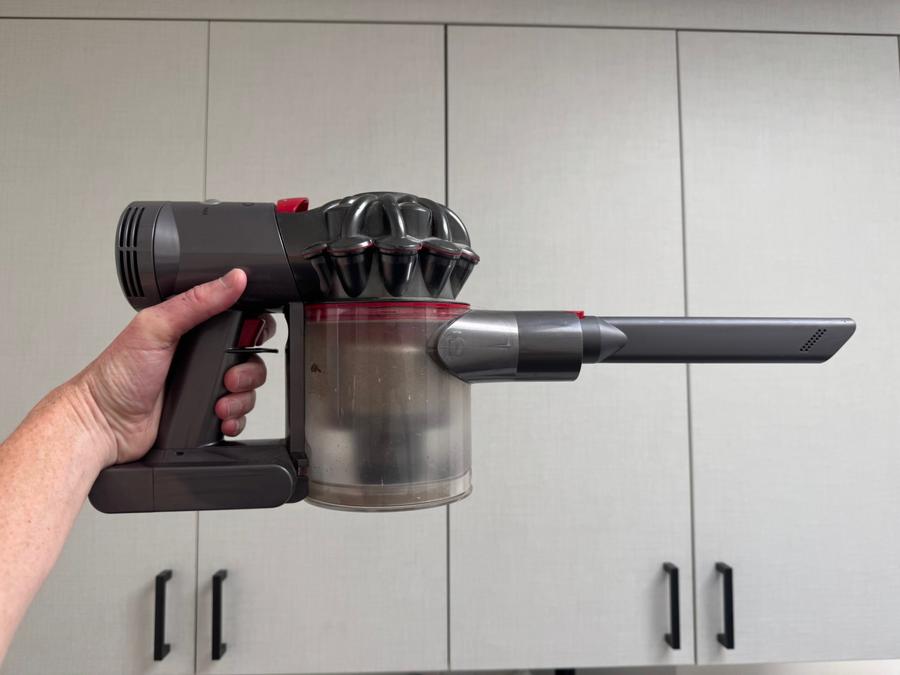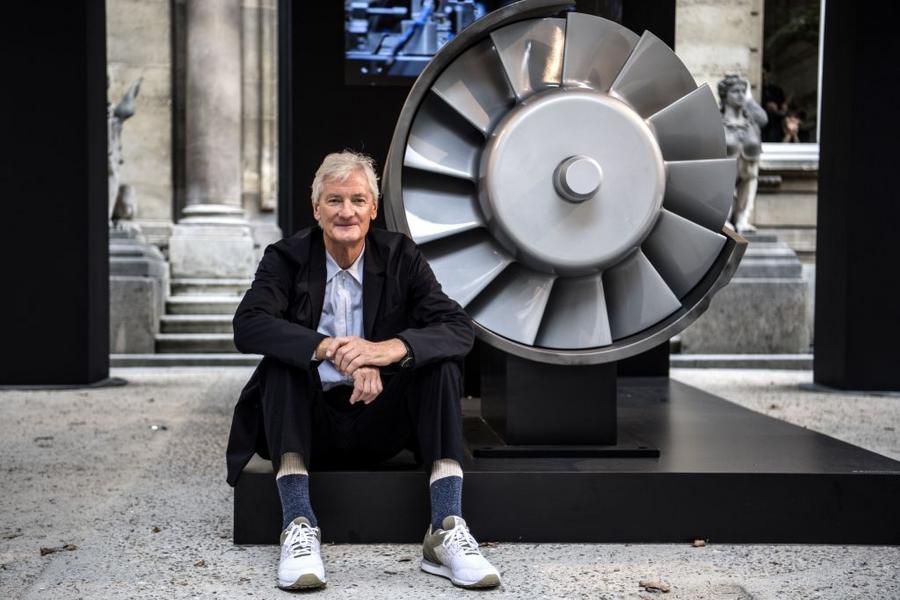I got married a few years back. And, as you know, when you get married, you register for a bunch of gifts. I'm so sorry if anyone reading attended my wedding and got me a gift, but, frankly, I could not have cared less about all the plates, pots, pans, bowls, wine glasses, and other kitchenware that we received. And that's an especially terrible thing to say because I REGISTERED FOR THEM.
Ironically, the ONE gift I absolutely love was not on our registry at all. That gift is a Dyson V7 Trigger cordless hand vacuum. A couple who could not attend our wedding sent it to us with a note that said something like, "I know this wasn't on your registry, but we are obsessed with this vacuum."
I am now equally obsessed with this vacuum. I use it several times a day, and it is the most satisfying and hard-working appliance I've ever come across. To quote Ferris Bueller, "if you have the means, I highly recommend picking one up":

(via me)
As a Dyson superfan, naturally, I was glued to my screen when the company posted its latest product demo to the internet last week. In certain circles, James Dyson's launches are on the level of a Steve Jobs keynote. His latest invention? The "Dyson PencilVac Fluffycones." You should watch the whole demo, it's only around 8 minutes. But here are my top highlights:
- The world's thinnest vacuum (38mm, 1.8kg)
- New special cones that prevent hair from getting stuck on the tread
- 360-degree illumination for people (like me) who get extreme satisfaction out of seeing the dirt
But here's the thing that really blows my mind every time I think about James Dyson:
He owns 100% of his company.
And it's not a small company, Dyson generated more than $8 billion in revenue last year and $1.75 billion in profit. James has never taken the company public, never brought in private equity, and never diluted his ownership. As a result, James Dyson has quietly amassed an $18 billion fortune. That's enough to make him the richest person in England.
This is the story of how James Dyson turned 5,126 failures into one of the world's most profitable tech empires and an $18 billion fortune…

(CHRISTOPHE ARCHAMBAULT/Getty Images)
Humble Beginnings and a Curious Mind
James Dyson didn't set out to become one of the wealthiest inventors on the planet. He wasn't born into money, didn't attend elite engineering academies, and didn't have a crew of Silicon Valley VCs throwing cash at his first idea. He was just a guy who liked solving problems. As a young man growing up in rural England, Dyson was always tinkering—first with art, then with design, eventually discovering a fascination with the way things worked (and didn't).
He studied at the Royal College of Art, where he initially focused on furniture and interior design. But it was a different kind of project that changed everything: a wheelbarrow. Specifically, a high-performance, orange-colored wheelbarrow with a ball instead of a wheel. It was called the Ballbarrow. He came up with it in the early 1970s, patented it, and even got it on store shelves. It didn't make him rich, but it taught him a crucial lesson: innovation was possible, even in the most boring household items. You just had to look at the problem differently.
The Vacuum That Launched an Obsession
A few years later, Dyson had his eureka moment—though "eureka" might be too generous. One day, he was vacuuming his home and noticed his expensive machine was losing suction fast. He opened it up and discovered the bag was clogged with dust, cutting off airflow. Most people would change the bag and move on. Dyson went to his garage, grabbed some materials, and started sketching out a better system.
Inspired by industrial cyclones he had seen at a sawmill, he wondered: what if you could use centrifugal force to separate dust from air, instead of relying on a bag at all?
This kicked off a five-year obsession that would stretch his patience, his marriage, and his bank account to the breaking point. Over and over again, Dyson would build a prototype, test it, tweak it, and try again. Most of them didn't work. Some exploded. Some did nothing at all. He eventually built 5,126 different versions of the bagless vacuum before landing on the one that finally worked.
That number—5,126—is not a motivational exaggeration. It's the actual number of failed prototypes he built by hand. No teams of engineers. No venture funding. Just a guy, a garage, and a refusal to give up.
At one point, he had mortgaged his house, sunk all his savings into parts and tools, and still couldn't find a manufacturer willing to take a risk on his invention. Vacuum companies wanted nothing to do with a product that didn't require ongoing purchases of disposable bags. Retailers didn't believe customers would understand the technology. For a while, it looked like the greatest vacuum in the world might never make it to market.
But Dyson had one last idea: if nobody else would sell it, he would.
Breaking Through in Japan
When every major vacuum manufacturer in the United Kingdom rejected his invention, James Dyson looked abroad. In the early 1990s, he struck a licensing deal with a Japanese company called Apex. It wasn't glamorous. The product was branded the "G-Force" and sold mostly through infomercials. But the Japanese market responded with surprising enthusiasm. The G-Force was sleek, powerful, and unlike anything else on the market. It sold for the equivalent of $2,000 and even won a design award in Japan.
That unexpected success gave Dyson the confidence and the financial footing to take matters into his own hands. In 1993, he opened Dyson Ltd. in the UK and launched his first model, the DC01. It quickly became the best-selling vacuum cleaner in Britain. Customers loved the clear bin that showed exactly how much dirt was being sucked up, and they were thrilled to never buy vacuum bags again. It felt futuristic, practical, and just rebellious enough.
The Reluctant Empire Builder
Dyson's machines weren't cheap, but they worked better than anything else. Word spread. Sales grew. Competitors tried to copy the cyclonic technology, but Dyson aggressively defended his patents. With every new model, the company doubled down on design, engineering, and performance. No gimmicks. No shortcuts.
Instead of chasing trends, Dyson built an in-house engineering culture focused entirely on solving real problems. Whether it was hair getting tangled in vacuum rollers or lighting up dust in dark corners, Dyson engineers attacked it with obsessive attention to detail. That mindset extended to bladeless fans, air purifiers, hand dryers, hair dryers, and more.
By 2002, Dyson had captured more than 50% of the UK vacuum cleaner market. By 2005, it was dominating in the United States. Today, the company sells in more than 80 countries and brings in over $8 billion in annual revenue.
Through it all, James Dyson kept full control. He didn't take outside investment. He didn't go public. He refused to compromise the company's independence, even when it might have been easier to cash out or delegate power.
The Billionaire Engineer Who Refused to Stop Innovating
Most entrepreneurs who build an $8 billion-a-year company might take a breath. Not James Dyson. Instead of coasting, he poured more money into research and development. A lot more. Since 2021 alone, Dyson has invested more than $2.5 billion into R&D, which works out to over $9 million per week. That funding supports a global army of engineers and scientists working on projects that go far beyond vacuum cleaners.
The company's R&D footprint now spans the United States, the United Kingdom, Singapore, the Philippines, and Malaysia, with a 750-acre technology campus outside of Malmesbury, England, that looks more like a cutting-edge university than a corporate headquarters. Dyson's teams are constantly experimenting with robotics, batteries, machine learning, and even biomedical sensing.
In 2019, Dyson made a controversial but calculated move. He shifted the company's corporate headquarters from the UK to Singapore. The decision sparked political backlash, especially given his public support for Brexit. But the reasoning was strategic. Singapore is closer to Dyson's core manufacturing hubs and high-growth markets in Asia. It also offered a centralized base for the company's ambitious push into electric vehicles and battery technology, which were in development at the time.
A Legacy of Control
Today, James Dyson remains the sole owner of Dyson Ltd. That fact alone sets him apart from almost every other founder of a global tech company. He has never sold a single share of his business. Never diluted his stake. Never answered to venture capitalists or hedge funds.
What's even more remarkable is that Dyson's success has never been fueled by hype. No celebrity endorsements. No influencer marketing. No flashy Super Bowl ads. Just engineering, precision, and products that customers actually love.
Having vacuumed up an $18 billion fortune, it certainly doesn't suck to be James Dyson.
/2013/10/jeff-skoll.jpg)
/2015/12/thumb-1.jpg)
/2018/08/GettyImages-497643604.jpg)
/2015/09/GettyImages-187749334.jpg)
/2023/05/aaron-krause.png)
/2020/06/jb2.jpg)
/2009/09/Brad-Pitt.jpg)
/2009/09/Jennifer-Aniston.jpg)
/2017/02/GettyImages-528215436.jpg)
/2020/06/taylor.png)
/2020/01/lopez3.jpg)
/2009/11/George-Clooney.jpg)
/2018/03/GettyImages-821622848.jpg)
:strip_exif()/2015/09/GettyImages-476575299.jpg)
/2020/04/Megan-Fox.jpg)
/2019/11/GettyImages-1094653148.jpg)
/2009/09/Cristiano-Ronaldo.jpg)
:strip_exif()/2009/09/P-Diddy.jpg)
/2020/02/Angelina-Jolie.png)
/2019/04/rr.jpg)
/2019/10/denzel-washington-1.jpg)